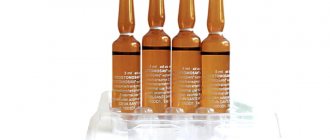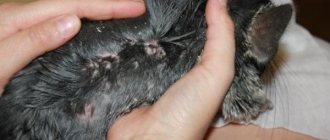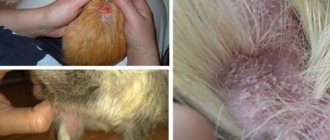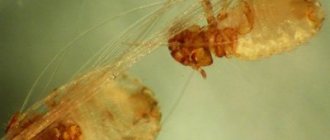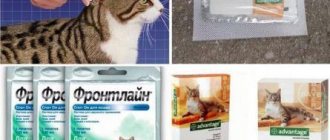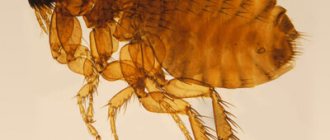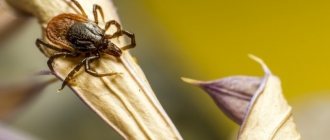- home
- Guinea pig
- Guinea pig health
01/28/2019 Guinea pigs are clean animals with long, thick fur. For their comfortable stay, the owner must regularly clean the cage and monitor the behavior of his pet. Parasites in guinea pigs are of the external type, which is why they begin to constantly itch, threatening to rip their skin until it bleeds. The problem that has arisen must be solved quickly - these rodents have fragile health.
Group of ectoparasites
This type includes skin types of parasites. The most common are skin lice, fleas and lice. The first symptoms of a pet infection include redness and itching of the skin, as well as hair loss in areas where microorganisms accumulate. It is this type of parasite that causes diseases that cause exhaustion, purulent ulcers, and in advanced cases, death. Moreover, the latter scenario can occur not only due to the animal’s lack of appetite, but also due to less obvious signs such as general blood poisoning. The fact is that toxic substances enter the blood through abrasions and microcracks formed by scratching the affected areas by the animal itself.
Fleas
Oddly enough, cat-type fleas are the most common in guinea pigs. These types of parasites can get onto an animal from anywhere, even from the owner’s skin. The symptoms of the disease are similar to the previous version: redness of the skin, itching, hair loss in the affected areas. Detecting fleas is not difficult: just comb your pet's fur thoroughly.
After thoroughly brushing your pet, it is important to check for insects between the teeth of the comb or comb. Fleas settle in the external environment (bedding, upholstered furniture, carpets); in animals they can only be detected during blood feeding. Guinea pigs become infected with these parasites from sick animals, most often dogs and cats.
The process of treating fleas itself is not so complicated, but the difficulty is that in addition to treating and monitoring the health of the sick animal, it is also necessary to monitor its environment, especially if there are small animals in the offspring. Treating the animal with topical shampoos and sprays is permissible; it is important that it contains pyrethritol. They also need to wash the cage and all accessible areas. In a couple of days of high-quality treatment of the animal, you can exterminate all pests along with their larvae.
Liver fluke - routes of infection and stages of treatment
A guinea pig can catch this type of parasite by drinking dirty water or eating low-quality food. At the initial stage, the pet becomes lethargic, eats poorly, and vomits. The pig's temperature gradually rises. When the initial stage ends, all symptoms may disappear, but the fluke has already settled in the animal’s liver and is destroying it. Treatment is usually long-term.
A liver fluke infection can only be accurately diagnosed by examining the animal at a veterinary clinic. If treatment is not started in a timely manner, he will die. Depending on what the tests show, the veterinarian will prescribe medications.
At the first stage, symptoms disturbing the mumps are relieved and the following are prescribed:
- anti-inflammatory drugs;
- antibiotics;
- hepatoprotectors;
- vitamins.
The second stage of treatment consists of anthelmintic therapy. Usually the animal is prescribed the anthelmintic drug Praziquantel.
Treatment ends with rehabilitation procedures. This is a diet and taking medications that restore damaged cells and tissues of internal organs.
Ticks
There are two types of mites on guinea pigs - subcutaneous and scabies. Each has characteristic features both in manifestation and in treatment.
Scabies type of mite
The difference between this type of mites lies in the fact that they can cause severe itching of the animal’s skin. The danger for the animal lies in the fact that not only the blood will be infected, but the animal may also die due to stress. The main symptoms of subcutaneous mite infestation include the following:
- skin itching;
- severe hair loss;
- redness and dryness of the skin;
- high temperature, chills;
- refusal to eat completely or partially.
Primary lesions in guinea pigs include the head, back, sides and shoulders. But if you do not pay attention to the problem in time, they can spread throughout the animal’s body, causing even more discomfort. It’s even worse if a pregnant female is infected with parasites. In this case, there is a risk of miscarriages and complications during pregnancy. Ticks can spread to mumps both from humans and from contact with other animals. You can only determine whether there are mites on your pet's skin using a scraping procedure. It is worth noting that treatment should apply not only to the infected animal, but also to its entire environment.
Along with the injections, it is necessary to thoroughly rinse the cage with a solution containing lime sulphide or chlorine.
Fur type mite
The difference from the previous species is that it settles, as a rule, on the surface of the skin. Symptoms of infection with the disease in an animal are similar to previous species. Only peeling of the skin is also observed. Refusal of water and restlessness of the animal are typical symptoms of a tick. If the infection is severe, painful ulcers may appear on the skin, and fur will begin to fall out at an increased rate. It is worth noting that the fur type of tick is transmitted only through direct contact between a healthy and sick animal. The treatment method is similar to the previous analogue. The room where the sick animal is located should be treated with a special anti-tick compound.
Where do parasites come from in guinea pigs?
Guinea pigs are dangerous precisely from ectoparasites, which they can pick up from other animals or insects that enter their homes in search of food. Infection can also be caused by poor quality food or toys.
These parasites do not live or reproduce in humans, but a person is able to bring them on his clothes - as soon as you pick up a pig or stroke it, uninvited guests will settle on it.
If your guinea pig has recently moved or traveled, it could have picked up ectoparasites along the way - through a ventilation window. You should not allow strangers into your pet’s cage if you are not sure that they are harmless.
Lice
Despite the rarer occurrence of this type of parasite, they can occur even with good care of the pet. And, most dangerously, it can be transmitted to humans through contact with a sick animal. Lice cause the appearance of pediculosis, which is characterized by severe itching, obesity and increased temperature of the animal. Lice can be treated using fairly gentle methods: if the infestation is not so local, you can use specialized shampoos. Veterinarians recommend treating the animal with a 10-day course of ivarmectin just in case. The pig's cage must be washed with a solution containing chlorine. It is also necessary to shampoo all pets that have previously come into contact with the infected person.
lice eaters
This is another type of parasite that differs in that it can feed not only on particles of the animal’s skin, but also on its blood. Due to the small size of the parasites, it is quite difficult to detect them with the naked eye; you will have to use scraping. The first signs include hair loss of the animal, as well as itching. An animal's reduced appetite threatens death from exhaustion. The danger is that lice can get on the animal even with careful care, for example, through the owner’s clothes or toys from the store.
Comprehensive treatment measures include treating all animals that have previously been in contact with or are close to an infected individual, even if they do not show signs of infection.
Akaromectin, Bolfo and Bars spray can be used as medical assistants in the fight against lice eaters. Due to the fact that bathing is considered extremely stressful for pigs, it is best to opt for a spray, as it will cause them less discomfort. The animal does not resist the procedure and, if necessary, it must be repeated the prescribed number of times. This is usually done by a veterinarian. Lice remedies are also available in human pharmacies, but you need to choose those options that contain the substance permethrin. The largest number of breeders recommend choosing Advocate spray. Due to the content of fewer toxic substances, it is safer for the animal.
Lice eaters are localized in the croup and perineum; they parasitize at the roots of the hair, wrapping their limbs around the hair, and feed on blood, epidermal scales and secretions of the sebaceous glands. As a result, the affected hair falls out. Lice eaters are most active in winter, when the guinea pig's fur becomes thicker and longer, which is a favorable factor for the proliferation of parasites.
Lice feed on blood and are able to actively move around the animal’s body, causing itching. Parasites can be seen with the naked eye when parting the fur, mainly in the head area and around the ears.
Guinea pigs become infected with lice and lice through contact with sick relatives, through bedding and food.
Lice and lice cause itchy skin and severe anxiety in a sick animal, up to the appearance of seizures and convulsions. Fleas with intense infestation can cause inflammation of the skin - flea dermatitis. It is characterized by redness of the skin, baldness, and eczema.
Trixacarosis
The causative agent of the disease is the microscopic scabies mite Trixacarus caviae, which parasitizes the subcutaneous layer. It differs in that it affects only guinea pigs, so infection occurs exclusively through sick relatives.
This disease is especially difficult for young and elderly individuals, animals exhausted by other diseases, pregnant females and pigs that are kept in inappropriate conditions. Suspicion of trixcarosis arises from the following signs:
- severe itching and soreness of the affected areas of the skin;
- the animal scratches the skin with its claws and teeth;
- hair loss and the appearance of significant areas of baldness;
- open ulcers and wounds on the skin;
- lethargy of the animal, refusal of food and drink;
- cramps.
If the disease is advanced, the female may have a miscarriage. If animals are not treated at all, they die.
Trixacarosis is diagnosed by skin scraping in a veterinary clinic, and the animal is treated there.
As treatment, injections are prescribed with one of the antiparasitic drugs: otodectin, ivermectin, ivermec or novomec.
Worms
Due to the fact that the main property of this group of parasites is to absorb nutrients from the animal’s blood, this can lead to exhaustion. Typically, guinea pigs are inhabited by tape and round parasites. Worm larvae of this type are dangerous not only for the animal, but also for the owner. With severe infection, you can see not only worm larvae in the stool, but also quite adult individuals with the naked eye. The animal is characterized by lethargic behavior, drowsiness and decreased appetite. If the infection is very strong, parasites crawling out of the anus can also be seen with the naked eye.
If the infection is not severe, you can give the animal a suspension of prazicide for kittens. The amount is calculated at the rate of 1 gram per 1 kg of animal weight. Dirofen paste has a good reputation among veterinarians. When treating an animal with medications, you need to treat the cage and accessories with a chlorine-containing solution.
Prevention
If in addition to the guinea pig, there are other pets in the house - cats or dogs, they must be regularly treated with insecticides so that they do not catch the infection and “reward” the little pet with it. This rule especially applies to those pets who are allowed to go outside for a walk.
The usual requirements for the conditions of keeping a pig play the role of preventive measures. These include:
- cleaning the animal's house;
- changing filler and bedding;
- treating the pet's cage and items with disinfectants.
All this should be done regularly and on an ongoing basis, and not just during or after an illness. Before going on walks, your pig needs to be protected against parasites.
It is very important to seek medical help at the first symptoms of infection. The consequences of an advanced disease are irreversible for the animal’s body, which leads to its death. The sooner treatment is started, the greater the chances of ridding your pet of the disease and returning him to his normal life and normal well-being.
It is not worth treating the animal on your own - only a veterinarian can prescribe the correct treatment. Self-selected therapy can cost the animal its life. Control by a veterinarian and a responsible approach to healing your pet are the key conditions that will soon allow you to see your pet healthy and active.
